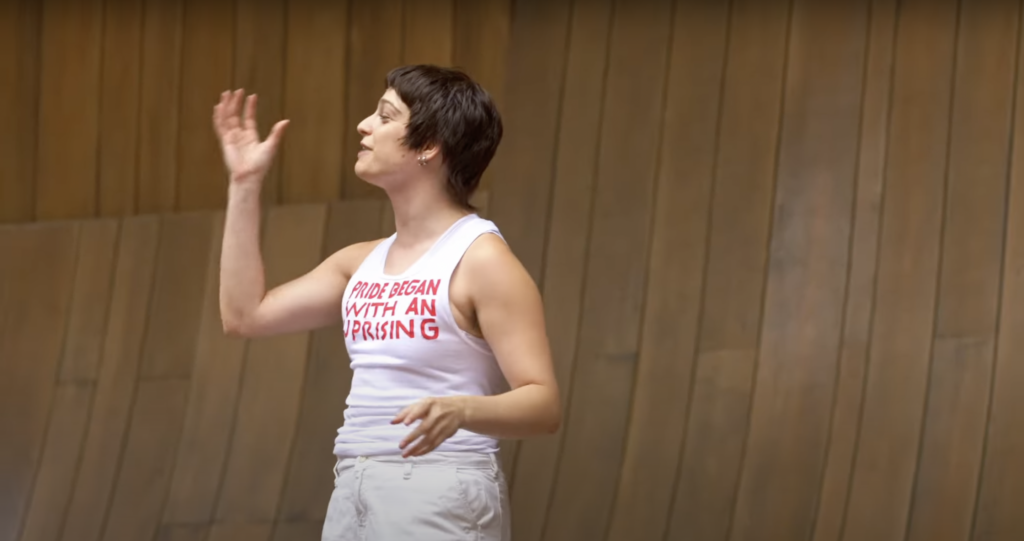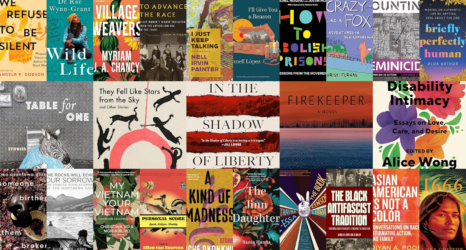I, Joan is a raw and pointed affirmation of trans and nonbinary lives. It also makes a lot of cisgender people, including some feminists, uncomfortable.

This year we’ve seen an incredible escalation in the war on transgender rights. In the United States, over 155 bills restricting or banning basic human rights for transgender people have been introduced as of Oct. 2022. And in England, trans-exclusionary radical feminists (TERFs) who root gender in biology and reject that trans and nonbinary people are valid are having their moment in the sun — lauded by politicians and the press — and are influencing the rise in anti-trans legislation.
In a brilliant stroke of timing, however, Shakespeare’s Globe in London produced a play this summer that reimagined one of history’s greatest gender transgressors. Inspiring a whirlwind of controversy, I, Joan is a feminist, queer and trans re-telling of the iconic story of Joan of Arc written by Charlie Josephine. It is also a much-needed respite from the onslaught of transphobia that pervades popular media today.
I saw the show in August when I was in London participating in a study abroad experience with other Oregon State University students and faculty.
In this version, Josephine imagines Joan as a nonbinary person — and a queer, nonbinary actor, Isabel Thom, plays Joan. Throughout the show, we see Joan pushing against the constraints of gender.
Perhaps one of the most powerful moments of the play occurs in the first few minutes when a non-binary Joan wearing a chest binder, blue jeans with a trans pride flag sewn onto the back pocket, and trans pride colored socks loudly voices a trans manifesto. “Trans people,” they proclaim, “are sacred. We are the divine.”

As a trans American in the audience, my heart swelled with pride and solidarity. I looked at my trans colleagues seated next to me and saw tears of joy in their eyes and heard the loud cheers of queers in the audience. This was a moment of celebration and pride that underlined the importance of reinterpreting history in ways that challenge and contest binary and heteronormative expectations.
Yet, at that moment when my colleagues and I were feeling unabashed joy and pride in our community, we noticed that many audience members were making a point of leaving the play, making their disgust known. It was at that moment that Thom as Joan raised their voice and continued with the manifesto in a display of trans power.
The show is a raw and pointed affirmation of trans and non-binary lives. It also makes a lot of cisgender people, including some feminists, uncomfortable.
Critics of the play have accused I, Joan of being an attack on women’s history and of pandering to liberal politics. What we see in many of these criticisms is really a thinly veiled transphobia masquerading as feminist thought. Ironically, those who have made the claim that this play is an affront to women’s history are outright ignoring that Joan was not persecuted (and eventually burned at the stake) for being a woman. As Leslie Feinberg pointed out in Transgender Warriors, Joan was killed for transgressing binary gender.
We can reclaim Joan both as an icon of women’s history and an icon of trans history. We don’t have to choose.
Additionally, those who critique the play as anti-woman have blatantly ignored the consistent feminist themes throughout the play. Joan replies to the myriad sexist remarks made about their gender with snarky quips such as “The men talk about me as if I’m not here,” and “Is this what it’s like to be a man? So sure of themselves!” Joan pushes back against the French noblewomen who normalize their abuse at the hands of men and expect Joan to do the same as a matter of gender.
Again and again, Joan rejects efforts to force them into binary gender. The historical Joan did this as well.
Court documents from Joan’s execution detail at length how Joan’s insistence on being perceived as male was blasphemous and that Joan proclaimed that they would rather die than present themself as female. Even after Joan’s execution, people gathered to view their naked flesh, “proving” their assigned sex at birth.
What more evidence do we need that Joan was a person who dared to push the boundaries of binary gender, challenged the sexist and patriarchal nobility who profited from their labor and emerged a feminist hero? After all, it is possible to be both a feminist hero and a transgender or gender non-conforming person. We can reclaim Joan both as an icon of women’s history and an icon of trans history. We don’t have to choose.
Throughout the play, Josephine connects modern-day attacks on trans human rights to Joan’s experiences in feudal France, demonstrating that the pathologization and ridicule of trans bodies is not a product of recent history — as evidenced by Queen Marie calling Joan a “beast” and exclaiming, “I don’t know what you are.” Joan is also subjected to genital examinations, similar to many of today’s demands that trans people “prove” their gender by physical examination.
I, Joan serves an important function in the preservation of historical icons who dared to transgress gender.
To reimagine Joan as non-binary takes little effort, as we see the historical facts of Joan’s story as someone who rejected expectations of gender and refused to conform to the day’s social and religious demands of someone assigned female at birth. The play powerfully embraces the both/and of feminist and trans/queer possibilities for understanding and celebrating Joan.
After the play, I walked along the Thames with my friends from Oregon State University. We are a group comprised of cisgender, non-binary and transgender students. That night, the solidarity felt palpable. We had conversations about the complexity of gender and the absurdity of attacks on transgender rights. I noticed relief and happiness wash over my trans and non-binary friends’ faces. It’s rare that we are made to feel supported by large groups of cisgender people.
As a trans person, I’m used to seeing people like me demonized in the media. Our lives are often represented by tragedy. While I, Joan certainly does not have a happy ending, this play serves an important function in the preservation of historical icons who have dared to transgress gender. Critics of this play should ask themselves why discussions of gender fluidity and identity are so upsetting to them. Their consternation at a non-binary Joan may say much more about them than it does the play.
U.S. democracy is at a dangerous inflection point—from the demise of abortion rights, to a lack of pay equity and parental leave, to skyrocketing maternal mortality, and attacks on trans health. Left unchecked, these crises will lead to wider gaps in political participation and representation. For 50 years, Ms. has been forging feminist journalism—reporting, rebelling and truth-telling from the front-lines, championing the Equal Rights Amendment, and centering the stories of those most impacted. With all that’s at stake for equality, we are redoubling our commitment for the next 50 years. In turn, we need your help, Support Ms. today with a donation—any amount that is meaningful to you. For as little as $5 each month, you’ll receive the print magazine along with our e-newsletters, action alerts, and invitations to Ms. Studios events and podcasts. We are grateful for your loyalty and ferocity.
Read more:





